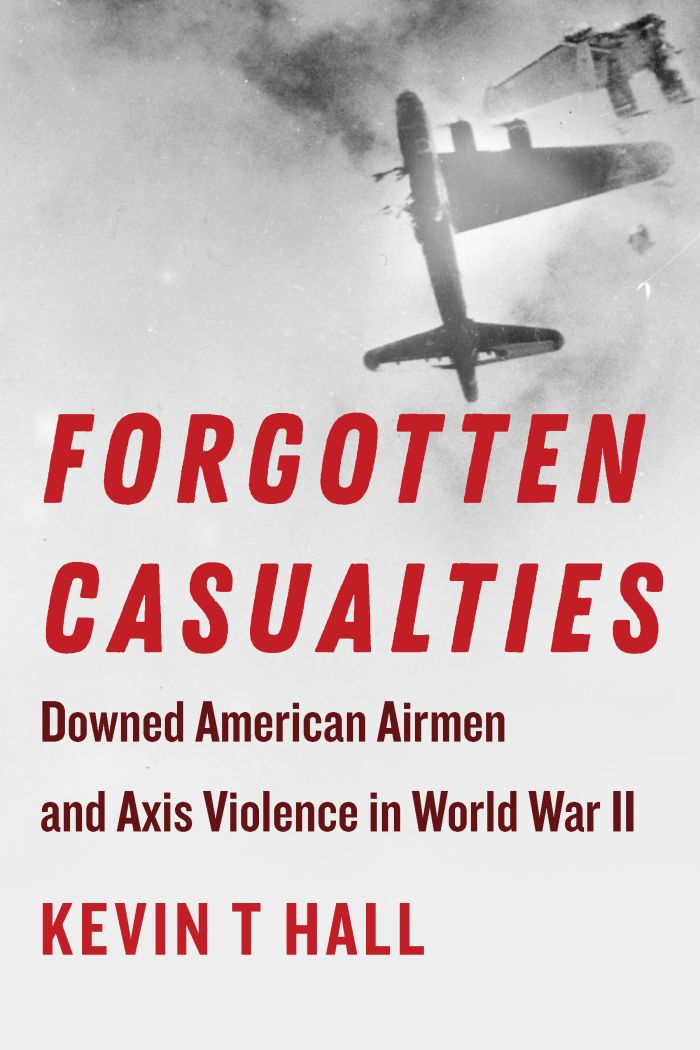Forgotten Casualties
Downed American Airmen and Axis Violence in World War II

This book can be opened with

Sheds new light on the mistreatment of downed airmen during World War II and the overall relationship between the air war and state-sponsored violence.
Throughout the vast expanse of the Pacific, the remoteness of Southeast Asia, and the rural and urban communities in Nazi-occupied Europe, more than 120,000 American airmen were shot down over enemy territory during World War II, thousands of whom were mistreated and executed. The perpetrators were not just solely fanatical soldiers or Nazi zealots but also ordinary civilians triggered by the death and devastation inflicted by the war. In Forgotten Casualties, author Kevin T Hall examines Axis violence inflicted on downed Allied airmen during this global war.
Compared with all other armed conflicts, World War II exhibited the most widespread and ruthless violence committed against airmen. Flyers were deemed guilty because of their association with the Allied air forces, and their fate remained in the hands of their often-hostile captors. Axis citizens angered by the devastation inflicted by the war, along with the regimes’ consent and often encouragement of citizens to take matters into their own hands, resulted in thousands of Allied flyers’ being mistreated and executed by enraged civilians.
Written to help advance the relatively limited discourse on the mistreatment against flyers in World War II, Forgotten Casualties is the first book to analyze the Axis violence committed against Allied airmen in a comparative, international perspective. Effectively comparing and contrasting the treatment of POWs in Germany with that of their counterparts in Japan, Hall’s thorough analysis of rarely seen primary and secondary sources sheds new light on the largely overlooked complex relationship among the air war, propaganda, the role of civilians, and state-sponsored terror during the radicalized conflict. Sources include postwar trial testimonies, Missing Air Crew Reports (MACR), Escape and Evasion reports, perpetrators’ explanations and rationalizations for their actions, extensive judicial sources, transcripts of court proceedings, autopsy reports, appeals for clemency, and justifications for verdicts.
Drawing heavily on airmen’s personal accounts and the testimonies of both witnesses and perpetrators from the postwar crimes trials, Forgotten Casualties offers a new narrative of this largely overlooked aspect of Axis violence.
Kevin Hall shows that crimes against American airmen were not only conditioned by the vicissitudes of the war but by the xenophobic racism of the Nazi and Japanese governments. He proves that warfare is indeed a bad taste business, and never more so than when a barbarous regime knows it is losing. Through seldom-consulted sources, Hall tells the stories of the Allied flyers in detailed and macabre technicolor. Abundant photographs throughout the book help restore humanity to the forgotten victims. At the end, the reader sees that these were very young men not far removed from their high school prom. They were scarcely out of boyhood when their lives were so senselessly and callously taken from them. Hall has written a poignant book that breaks the heart.—Michael Bryant, Professor of History and Legal Studies at Bryant University, and author of A World History of War Crimes: From Antiquity to the Present
Kevin Hall's new book provides an intriguing study that will be essential reading to anyone interested in the air war of World War II and the treatment of prisoners in Axis countries. It is buttressed by gripping narratives of the downed flyers in both Germany and Japan and by an analysis of the perpetrators in the post-war trials held in Nuremberg, Tokyo and Yokohama, as well as many other trial locations in the vast Pacific region previously controlled by the Japanese. Lastly, it highlights the differences and similarities in the treatment of downed flyers in the two countries. For example, in Germany, civilians played a larger role in the mistreatment of airmen, while in Japan, military police and government officials took a stronger role, frequently ordering the cremation of executed airmen.—Eric A. Johnson, Professor Emeritus of History at Central Michigan University, and author of Nazi Terror: The Gestapo, Jews and Ordinary Germans
This well-researched book reaches into the darkest side of the POW experience during the closing months of WWII. Hall challenges readers to imagine the captors’ worst behaviors toward prisoners of war, mostly shootdowns of B-29 bombers over Japan in 1945 and B-17s and B-24s over Germany in1944–45. Highly recommended.—Choice Reviews
List of Abbreviations | ix
Introduction | 1
1. Axis Policies to Combat Downed Enemy Flyers | 29
2. War Crimes Narratives: Pacific and Southeast Asia | 63
3. War Crimes Narratives: Europe | 104
4. US Postwar Flyer Trials | 129
Conclusion | 143
Appendix: Index of Analyzed US Flyer Trials Held in the Pacific and Southeast Asia | 151
Acknowledgments | 243
Notes | 245
Bibliography | 271
Index | 303




